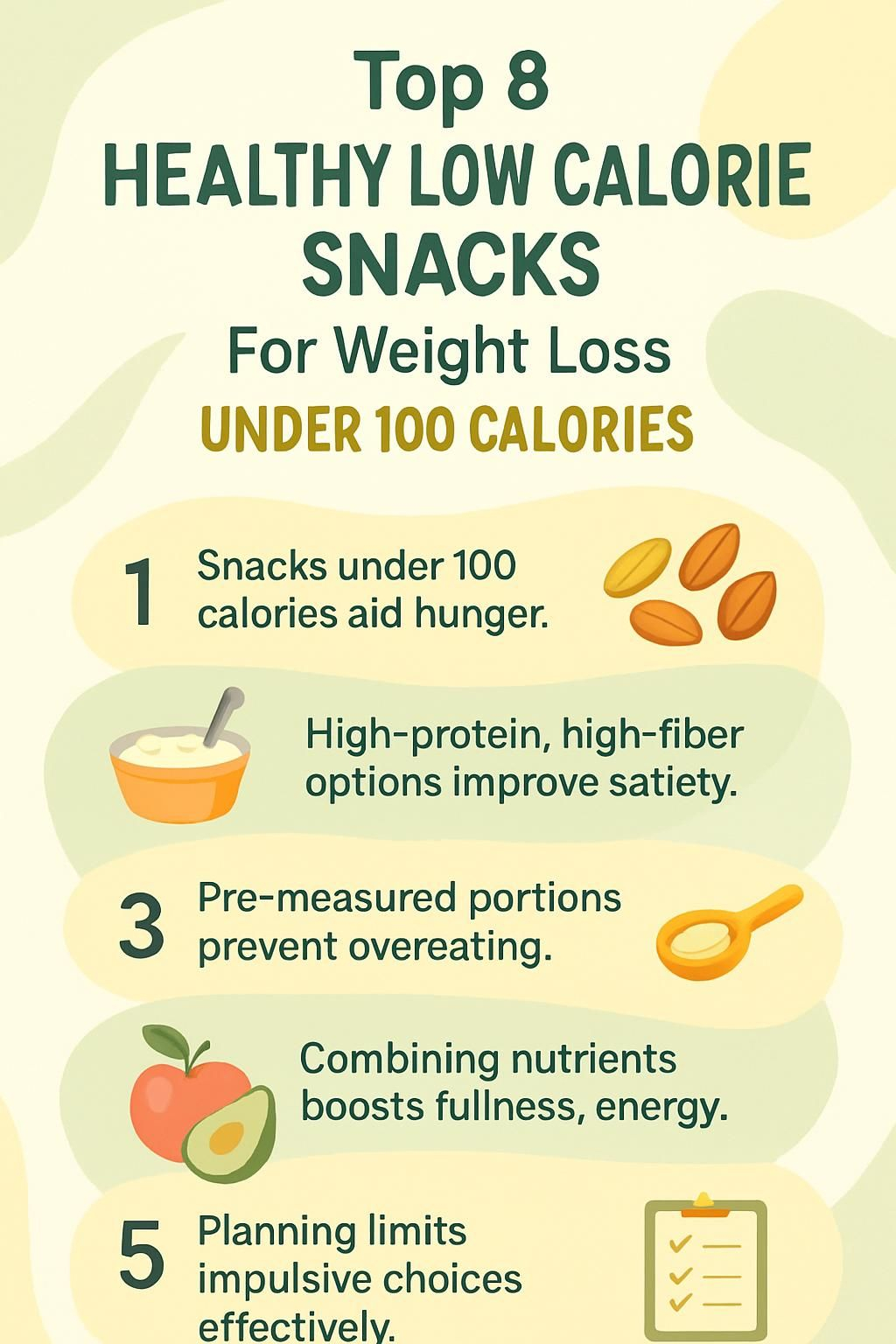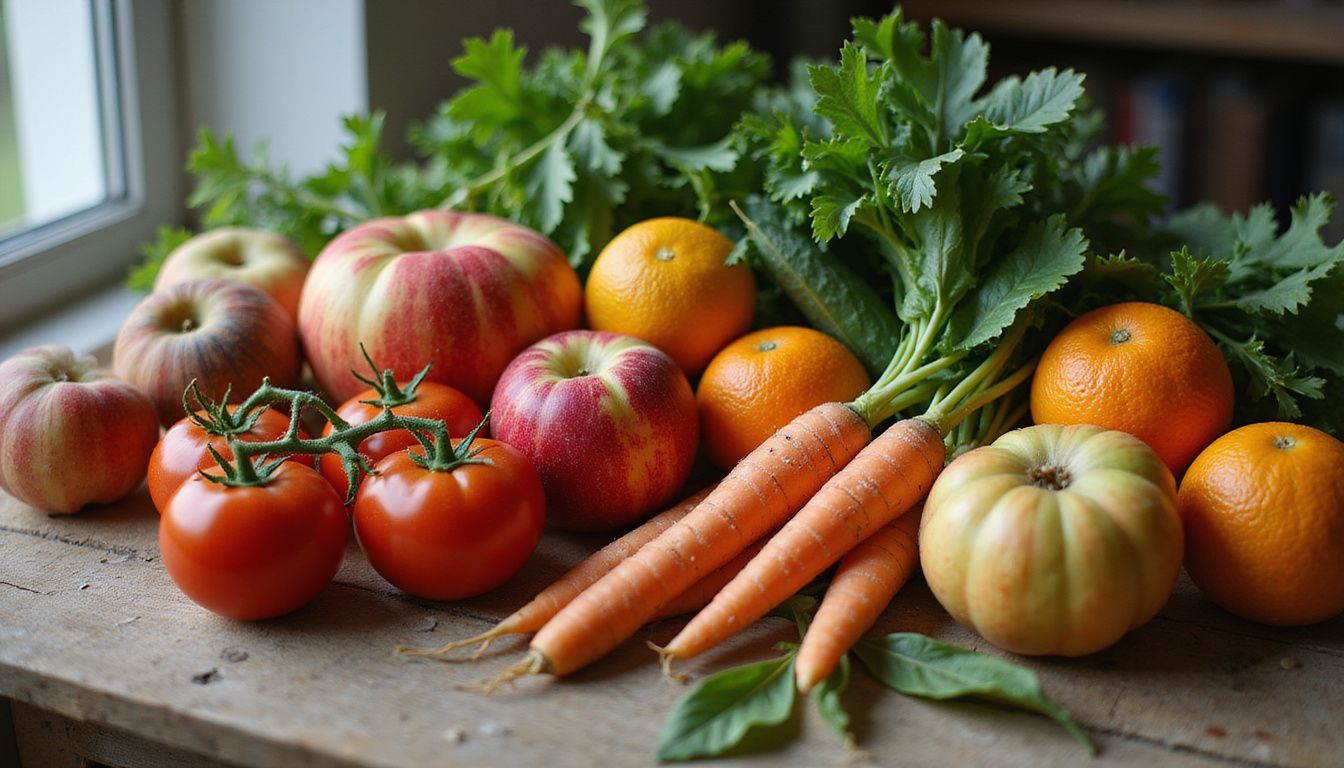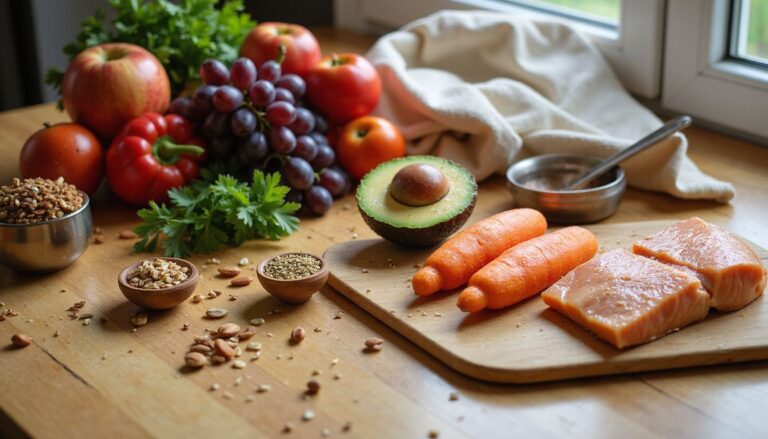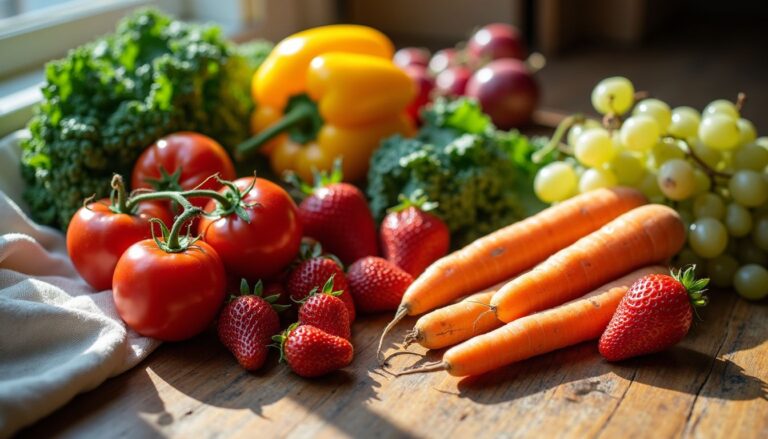Top 8 Healthy Low Calorie Snacks For Weight Loss Under 100 Calories
Our Nutrition Assistant AI Suite will transform your body. You will lose fat, get toned, and build muscle. Gain confidence and optimal health.
You want snacks that taste good and still support your goals. Choosing low-calorie snacks can help manage hunger, steady energy, and make healthy eating feel easier. The ideas below offer simple, satisfying options, many under 100 calories, to support snacks for weight loss.
Each option focuses on protein, fiber, or key vitamins, which help you stay full longer. You will also find quick swaps for common treats and easy tips to cut cravings without feeling deprived.
Key Takeaways
- Picking snacks under 100 calories, like air-popped popcorn or Greek yogurt with honey, can help you manage hunger and support weight loss, according to Harvard T.H. Chan School of Public Health.[1]
- High-protein and high-fiber picks, such as edamame or cottage cheese, create longer satiety compared with processed snacks high in added sugars or unhealthy fats.
- Portion control matters. Pre-measured servings, like frozen banana pops or kale chips, help you avoid overeating and reduce calorie intake.
- Combining protein, fiber, and healthy fats boosts fullness, manages cravings, and supports steady energy while keeping within daily calorie goals suggested by dietitians.[2]
- Planning nutrient-rich foods limits impulsive choices. Staying hydrated supports digestion and helps control appetite between meals.

Benefits of Low-Calorie Snacks for Weight Loss

Low-calorie snacks help you control your calorie count without feeling deprived. Small, smart choices between meals can cut cravings and improve your eating pattern.
How do snacks fit into a balanced diet?
Snacks with 100 calories or less can fill nutrient gaps between meals. Options like baby carrots, Greek yogurt, and air-popped popcorn raise your intake of fruits, vegetables, and whole grains.
Adding items such as cottage cheese or plain yogurt increases protein and calcium, two nutrients that support fullness. Pairing apple slices with a teaspoon of peanut butter blends fiber and healthy fats, so you get satiety without a big calorie hit.
Rotating whole-grain crackers, chickpeas, nuts, or edamame can keep your energy steady through the afternoon. These choices help prevent blood sugar dips and reduce urges for junk food that is high in added sugar and fat.
How can low-calorie snacks help prevent overeating?
Low-calorie snacks give you a steady energy boost between meals without pushing your daily total too high. Air-popped popcorn, baby carrots with hummus, or apple slices with peanut butter can calm hunger and tame cravings.
Protein and fiber, found in Greek yogurt or steamed edamame, slow digestion. That means you feel satisfied longer and are less likely to overeat later. Aiming for snacks under 100 to 150 calories can help curb appetite at mealtime.
Portion-controlled options also reduce the pull of processed snacks that carry extra salt, sugar, and unhealthy fats. Keep two or three ready-to-eat choices nearby during the day, and the vending machine will lose its appeal.
Choosing the right snack helps you control hunger while staying aligned with your goals.
Pack small bags of kale chips and a few almonds for breaks. Many readers find this simple swap is more satisfying than skipping snacks or grabbing cookies from a vending machine.
Key Factors for Choosing Healthy Low-Calorie Snacks
Picking the right snack comes down to nutrients, portions, and staying power. Focus on the mix that keeps you full without blowing your calorie budget.
What nutritional values should I look for?
Choose snacks that deliver protein, dietary fiber, antioxidants, and key vitamins and minerals. For example, 1/2 cup of plain nonfat Greek yogurt provides about 12 grams of protein and roughly 84 calories, even with a teaspoon of honey.
Steamed edamame gives over 8 grams of plant-based protein and about 4 grams of fiber per one-third cup, all under 100 calories. These nutrients help you stay full and steady your energy.
Keep saturated fat and sodium low to support heart health. About 14 almonds provide less than one gram of saturated fat and nearly no sodium within 100 calories. Limit added sugars by pairing low-fat cottage cheese with cantaloupe. Together, they hit around 100 calories and deliver roughly 14 grams of protein when portions total 1/2 cup.
Frozen mango cubes offer vitamin C with few calories. Three-quarters of a cup gives about 90 calories and a big boost of this antioxidant vitamin.
How does portion control affect snack choices?
Portion control keeps your snack calories in check. Aim for 100 to 150 calories per serving. You could pick 6 cups of air-popped popcorn for about 100 calories or enjoy 20 pistachios for roughly 80 calories.
Measure servings instead of eating from a full bag. That habit avoids hidden calories from items like trail mix or a whole avocado. Small portions make it easier to include heart-healthy snacks such as baby carrots with hummus or apple slices with peanut butter.
Use measuring spoons and prep small servings in advance. This simple step saves time and helps you avoid mindless eating during busy afternoons.
How do snacks provide satiety and satisfaction?
Protein, fiber, and healthy fats team up to control hunger. Greek yogurt, edamame, and cottage cheese slow digestion, which increases satiety.
Popcorn is another strong pick. Six cups of air-popped kernels deliver about 6 grams of fiber, which supports fullness. Crunchy vegetables with hummus add texture and nutrients, which can make a small portion feel more satisfying.
Healthy fats from almonds or a teaspoon of peanut butter also help curb cravings. Pairing fruit with a little nut butter balances natural sugars with fat and a bit of protein. That mix helps steady blood sugar and reduce overeating later.
1. Air-Popped Popcorn (6 Cups)
Air-popped popcorn offers big volume and crunch for very few calories. Six cups stay under 100 calories and bring fiber to help you feel full.
What is the nutritional content of air-popped popcorn?
Popcorn can be a smart, low-calorie choice when you keep it simple.
- Six cups of air-popped or plain microwave popcorn have about 100 calories.
- Roughly 0.5 grams of saturated fat per serving, with zero milligrams of cholesterol.
- About 220 milligrams of sodium in some microwave versions. Use less salt to lower this.
- About 24 grams of carbohydrates for six cups, mostly from whole-grain corn.
- Approximately 6 grams of dietary fiber per serving to support fullness and digestion.
- Very little total fat and no cholesterol compared with fried or frosted snacks.
- Satisfying crunch without sauces or high-fat toppings.
- Air-popped options avoid added oils found in many packaged snacks.
- Naturally gluten-free and fits many healthy eating plans.
- Easy to portion and carry, which helps prevent blood sugar spikes between meals.
Why is air-popped popcorn a great low-calorie snack?
You can enjoy 6 cups for under 100 calories. That large portion keeps your hands busy and your mouth satisfied without excess fat or cholesterol.
The fiber helps you stay full longer than many crackers. Skip butter or heavy oils and enjoy the natural taste. Popcorn’s whole-grain nutrients and crunchy texture make it a smart swap for chips.
2. Baby Carrots with Hummus (8 Carrots + 1 Tbsp Hummus)
Crunchy carrots with creamy hummus deliver flavor and balance. Pairing vegetables with plant-based protein supports fullness and fits a tight calorie budget.
What are the nutrition facts of baby carrots with hummus?
This combo is simple, tasty, and easy to pack.
- Eight baby carrots plus one to two tablespoons of hummus total under 100 calories.
- About 0.4 grams of saturated fat, which supports a low-fat diet.
- Roughly 210 milligrams of sodium, depending on the hummus brand.
- Cholesterol is 0 milligrams.
- Carrots provide fiber and vitamin A for healthy skin and vision.
- Hummus supplies plant-based protein from chickpeas to help control cravings.
- Minerals such as potassium and magnesium support fluid balance and nerves.
- Crunchy plus creamy texture increases satisfaction without extra calories.
- Fiber from both parts helps prevent overeating later.
- Portable for lunchboxes, desks, or quick after-school snacks.
How does this snack support weight loss?
Carrot fiber slows digestion, which helps you stay full longer. Hummus provides plant protein and a little fat for steady energy, which supports appetite control.
Carrots add vitamin A and water for hydration. Tahini in hummus brings healthy fats and minerals. The built-in portion size makes it easy to stick to your plan without guesswork.
3. Cottage Cheese with Cantaloupe (1/4 Cup + 1/4 Cup)
This sweet and creamy duo gives protein, vitamins, and hydration in one bowl. It tastes like dessert, yet stays within a low-calorie range.
What nutrients are in cottage cheese with cantaloupe?
Pairing low-fat cottage cheese with fruit gives a strong nutrition return for the calories.
- About 7 grams of protein in 1/4 cup cottage cheese, or 14 grams in 1/2 cup, to support fullness.
- Cantaloupe delivers vitamins A and C for immune and skin health.
- Approximately 0.7 grams of saturated fat per serving when using low-fat cottage cheese.
- Sodium can be higher in cottage cheese. Drink water to balance fluid needs.
- Calcium and phosphorus in cottage cheese support strong bones and teeth.
- Low cholesterol when using low-fat styles, making it a heart-friendly option.
- Natural sweetness from fruit without heavy added sugars.
Why is this combination effective as a snack?
Protein from cottage cheese helps you stay full and protects lean muscle while you lose weight. Cantaloupe adds juicy sweetness and vitamin C with few calories.
The balance of carbs and protein satisfies without a sugar crash. It fits easily into breakfast, a snack, or a light dessert.
4. Frozen Banana Pops (1 Small Banana)
Frozen banana pops deliver a cool, creamy bite that feels like ice cream. You get a sweet treat that still fits under 100 calories.
What is the nutritional profile of frozen banana pops?
These pops are quick to make and easy to portion.
- One small banana dipped in about 1 ounce of low-fat yogurt comes in under 80 calories.
- Roughly 0.35 grams of saturated fat and about 3 milligrams of sodium.
- Only about 7 milligrams of cholesterol with low-fat yogurt.
- Bananas supply potassium and vitamin B6 for nerves and muscles.
- Minimal added sugar if you use plain fruit and unsweetened yogurt.
- No unhealthy fats compared with many frozen desserts.
- Yogurt adds a bit of protein for steadier energy than candy.
How do you prepare frozen banana pops?
You need only a few ingredients and a short prep time.
- Slice one small banana into bite-size pieces for easy portions.
- Dip slices in 1 ounce of low-fat yogurt for creamy texture without too many calories.
- Set pieces on parchment paper to prevent sticking.
- Add tiny toppings, such as chia seeds or a light sprinkle of cinnamon.
- Freeze for about two hours until firm.
- Store in an airtight container for grab-and-go snacks.
- If desired, add a few dark chocolate chips, used sparingly to stay under 100 calories.
For extra variety, add a few blueberries or chopped nuts to a portion. Keep amounts small so calories stay in range.
5. Greek Yogurt with Honey (1/2 Cup + 1 Tsp Honey)
Greek yogurt with a teaspoon of honey tastes rich and sweet. It is high in protein and easy to dress up with fruit.
What are the nutrition benefits of Greek yogurt with honey?
This simple mix is nutrient dense for the calories.
- Half a cup of nonfat Greek yogurt plus 1 teaspoon honey is about 84 calories.
- About 12 grams of protein per serving to support fullness and muscle health.
- Zero grams of saturated fat and about 53.5 milligrams of sodium.
- Calcium supports bones, teeth, and nerve function.
- Probiotics in yogurt can support gut health and digestion.
- No cholesterol when using nonfat styles.
- Honey brings natural sweetness and trace antioxidants.
- Pairs well with berries or a spoon of high-fiber cereal for variety.
- High-protein snacks can help regulate appetite during weight loss.[1][2]
- Easy to portion and store in the refrigerator for busy days.
How does protein in this snack help with satiety?
Protein slows digestion, which helps you feel full longer and cuts hunger between meals. With 12 grams of protein in a half cup, Greek yogurt is a strong base for a filling snack.
Protein also helps protect lean muscle while you lower calories. Add a small drizzle of honey for flavor without many extra calories.
6. Edamame (1/3 Cup Steamed)
Steamed edamame is a quick plant-based pick. It supplies protein and fiber that help you stay full.
What is the nutritional value of steamed edamame?
Edamame fits easily into a low-calorie plan and cooks fast.
- One-third cup of steamed edamame has under 100 calories.
- More than 8 grams of protein for lasting satiety.
- About 4 grams of fiber to support digestion and stable blood sugar.
- Roughly 0.5 grams of saturated fat per serving.
- Very low sodium, often under 5 milligrams per portion when unsalted.
- No cholesterol and modest carbohydrates.
- Provides iron, magnesium, and folate for energy and cell health.
- Umami flavor without added spices, flour, or heavy sauces.
Enjoy edamame on its own or toss it onto salads for extra texture and nutrients.
What benefits does plant-based protein provide?
Plant protein supports muscle maintenance without the cholesterol found in many animal foods. It usually comes with fiber and antioxidants, two perks you do not get from animal protein alone.
Snacks made with beans, oats, or legumes can aid digestion and support steady energy. These foods often have less saturated fat, which is good for your heart.
7. Kale Chips (1 Cup Homemade)
Homemade kale chips bake into a crunchy, savory snack. You control the oil and salt, which keeps calories low and nutrients high.
What nutrients are in homemade kale chips?
Kale chips offer vitamins, minerals, and a satisfying crunch.
- One cup can exceed 100 percent of your daily vitamin A target, which supports eye health.
- About 70 micrograms of vitamin K per cup for blood clotting and bones.
- Roughly 60 milligrams of vitamin C to support immunity.
- Potassium and calcium for heart and bone support, about 150 mg and 40 mg per cup.
- Antioxidants such as beta-carotene and lutein help reduce oxidative stress.
- Up to 2 grams of fiber per serving for digestive regularity.
- About 60 calories per cup when made with a light drizzle of olive oil.
- Healthy fats in olive oil help your body absorb fat-soluble vitamins.
- Great alternative to crackers or sugary snacks.
Season with garlic, vinegar, or a pinch of sea salt. Keep portions to one cup to stay well under 100 calories alongside another small item.
Why are kale chips a crunchy snack alternative?
Baked kale chips provide a crisp bite like potato chips but with fewer calories. Baking at home lets you control the ingredients and keep salt and oil in check.
Having kale chips ready on busy days can stop random snacking on less healthy items. You get volume, flavor, and fiber for very few calories.
8. Apple Slices with Peanut Butter (1/2 Apple + 1 Tsp Peanut Butter)
Apple slices with a little peanut butter pair fiber with healthy fats. The combo is quick, simple, and easy to portion.
What is the nutrition content of apple slices with peanut butter?
This snack balances sweet and creamy in a small calorie budget.
- About 3/4 cup apple plus 2 teaspoons unsalted peanut butter is roughly 90 calories.
- About 0.8 grams of saturated fat, fitting a heart-friendly plan.
- Very low sodium, about 2 milligrams. Cholesterol is 0 milligrams.
- Apple fiber supports fullness and digestive health.
- Peanut butter adds monounsaturated fats for satiety and steady energy.
- Vitamins include vitamin C from the fruit and vitamin E from the nut butter.
- Natural sweetness and creamy texture increase satisfaction.
- The mix of fiber, protein, and fat helps regulate blood sugar.
- Dietitians often suggest fruit with nut butter for easy, portion-controlled snacking.
- Use as a simple base for other ideas, like a few chia seeds or a berry topping.
How do fiber and healthy fats work together in this snack?
Fiber in apples slows digestion and supports fullness. Healthy fats in peanut butter help you feel satisfied and provide steady energy.
Together they reduce blood sugar spikes, which can limit cravings later. Half an apple with one teaspoon of peanut butter lands around 85 to 95 calories, yet feels filling.
How Can You Incorporate Low-Calorie Snacks Into Your Routine?
Two habits make the biggest difference. Plan your snacks and build each one around protein, fiber, and healthy fats.
Why should you plan your snacks ahead of time?
Planning stops impulse choices that add calories fast. Keep two to three ready options, like kale chips or apple with peanut butter, so healthy wins are easy.
Pre-portion snacks to manage calories and avoid grazing. Set aside small containers on weekends to make busy weekdays smoother. This simple system can reduce trips to the vending machine.
How to combine protein, fiber, and healthy fats effectively?
Build a balanced mini-meal by pairing one item from each category.
- Greek yogurt for protein, berries for fiber, and a few nuts for healthy fats.
- Apple slices for fiber with a teaspoon of peanut butter for fat and a bit of protein.
- Whole-grain crackers for fiber with low-fat cheese for protein and fat.
- 1/3 cup edamame for protein and fiber with a light drizzle of olive oil.
- Low-fat cottage cheese for protein plus fruit for fiber and vitamin C.
Keep portions small to stay under 100 calories per snack. The goal is steady energy and fewer cravings.
Why is staying hydrated important when snacking?
Water supports digestion and helps your body use fiber well. Hydration also makes it easier to tell hunger from thirst, which can prevent extra snacking.
Choose water or unsweetened drinks instead of sugary beverages. That choice cuts empty calories and helps you feel satisfied longer after high-fiber or higher-protein snacks like edamame or Greek yogurt.
Try a glass of water with a light snack to see how your appetite responds. Many readers notice better afternoon energy with this practice.
Conclusion
Choosing low-calorie snacks under 100 calories can help you manage hunger and support your goals. Options like air-popped popcorn, Greek yogurt with honey, and kale chips give you protein, fiber, and flavor in smart portions.
Plan ahead and keep a few favorites ready. Balanced snacks can prevent overeating and make your day feel easier. For personal guidance, talk with a registered dietitian. This content is educational and does not replace medical advice. Sources include the Harvard T.H. Chan School of Public Health and the Academy of Nutrition and Dietetics.[1][2]
References:
[1] Harvard T.H. Chan School of Public Health: The Nutrition Source – Healthy Snacks.
[2] Academy of Nutrition and Dietetics: Smart Snacking Tips for Adults
FAQs
1. What are some healthy low calorie snacks under 100 calories that help with weight loss?
Snacks like whole grain crackers, grilled salmon bites, and ginger-infused yogurt offer options under 100 calories. These foods provide nutrients while keeping calorie intake low.
2. How does grilling affect the nutritional value of salmon as a snack?
Grilling helps retain protein in salmon and keeps fat content lower than frying. Grilled salmon is also a good source of vitamin D and omega-3 fatty acids, both important for health during weight loss.
3. Can maple syrup be included in low calorie snacks for weight loss?
A small drizzle of pure maple syrup can add flavor to snacks such as plain yogurt or fruit without exceeding 100 calories if used sparingly. It offers natural sweetness but should be measured carefully to avoid extra sugar.
4. Why choose ginger as part of a healthy snack option?
Ginger adds flavor without many calories and may support digestion according to research from clinical nutrition studies (Smith et al., 2020). Including ginger in snacks like tea or mixed with fruit provides taste variety while supporting wellness goals.
Summary: Healthy low calorie snacks such as whole grain crackers, grilled fish portions, ginger-based treats, and lightly sweetened foods can fit into a balanced diet for weight management when portion sizes remain controlled and nutrient sources are prioritized (USDA FoodData Central).







